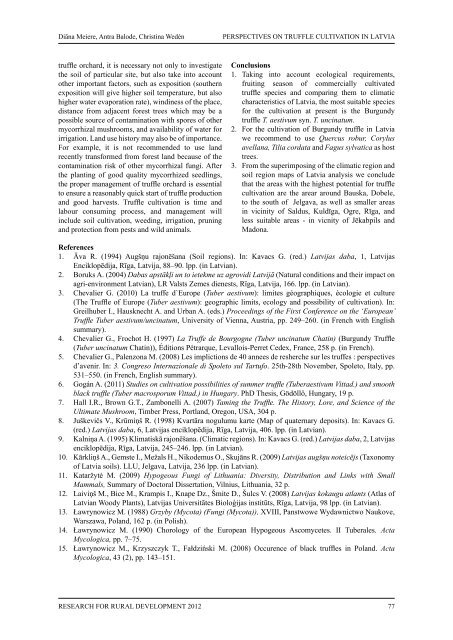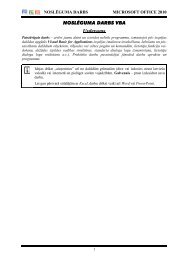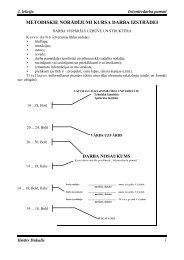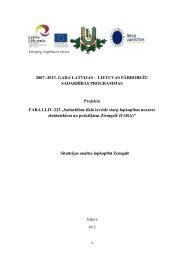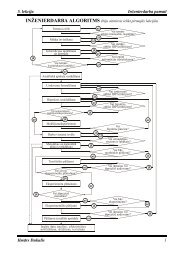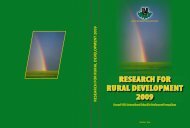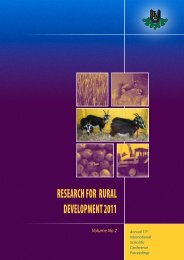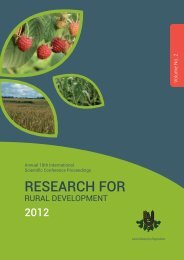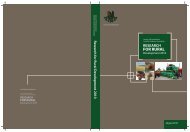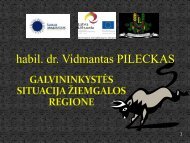LATVIA UNIVERSITY OF AGRICULTURE - Latvijas ...
LATVIA UNIVERSITY OF AGRICULTURE - Latvijas ...
LATVIA UNIVERSITY OF AGRICULTURE - Latvijas ...
- No tags were found...
You also want an ePaper? Increase the reach of your titles
YUMPU automatically turns print PDFs into web optimized ePapers that Google loves.
Diāna Meiere, Antra Balode, Christina WedénPERSPECTIVES ON TRUFFLE CULTIVATION IN <strong>LATVIA</strong>truffle orchard, it is necessary not only to investigatethe soil of particular site, but also take into accountother important factors, such as exposition (southernexposition will give higher soil temperature, but alsohigher water evaporation rate), windiness of the place,distance from adjacent forest trees which may be apossible source of contamination with spores of othermycorrhizal mushrooms, and availability of water forirrigation. Land use history may also be of importance.For example, it is not recommended to use landrecently transformed from forest land because of thecontamination risk of other mycorrhizal fungi. Afterthe planting of good quality mycorrhized seedlings,the proper management of truffle orchard is essentialto ensure a reasonably quick start of truffle productionand good harvests. Truffle cultivation is time andlabour consuming process, and management willinclude soil cultivation, weeding, irrigation, pruningand protection from pests and wild animals.Conclusions1. Taking into account ecological requirements,fruiting season of commercially cultivatedtruffle species and comparing them to climaticcharacteristics of Latvia, the most suitable speciesfor the cultivation at present is the Burgundytruffle T. aestivum syn. T. uncinatum.2. For the cultivation of Burgundy truffle in Latviawe recommend to use Quercus robur, Corylusavellana, Tilia cordata and Fagus sylvatica as hosttrees.3. From the superimposing of the climatic region andsoil region maps of Latvia analysis we concludethat the areas with the highest potential for trufflecultivation are the arear around Bauska, Dobele,to the south of Jelgava, as well as smaller areasin vicinity of Saldus, Kuldīga, Ogre, Rīga, andless suitable areas - in vicnity of Jēkabpils andMadona.References1. Āva R. (1994) Augšņu rajonēšana (Soil regions). In: Kavacs G. (red.) <strong>Latvijas</strong> daba, 1, <strong>Latvijas</strong>Enciklopēdija, Rīga, Latvija, 88–90. lpp. (in Latvian).2. Boruks A. (2004) Dabas apstākļi un to ietekme uz agrovidi Latvijā (Natural conditions and their impact onagri-environment Latvian), LR Valsts Zemes dienests, Rīga, Latvija, 166. lpp. (in Latvian).3. Chevalier G. (2010) La truffe d`Europe (Tuber aestivum): limites géographiques, écologie et culture(The Truffle of Europe (Tuber aestivum): geographic limits, ecology and possibility of cultivation). In:Greilhuber I., Hausknecht A. and Urban A. (eds.) Proceedings of the First Conference on the ‘European’Truffle Tuber aestivum/uncinatum, University of Vienna, Austria, pp. 249–260. (in French with Englishsummary).4. Chevalier G., Frochot H. (1997) La Truffe de Bourgogne (Tuber uncinatum Chatin) (Burgundy Truffle(Tuber uncinatum Chatin)), Éditions Pétrarque, Levallois-Perret Cedex, France, 258 p. (in French).5. Chevalier G., Palenzona M. (2008) Les implictions de 40 annees de resherche sur les truffes : perspectivesd’avenir. In: 3. Congreso Internazionale di Spoleto sul Tartufo. 25th-28th November, Spoleto, Italy, pp.531–550. (in French, English summary).6. Gogán A. (2011) Studies on cultivation possibilities of summer truffle (Tuberaestivum Vittad.) and smoothblack truffle (Tuber macrosporum Vittad.) in Hungary. PhD Thesis, Gödöllő, Hungary, 19 p.7. Hall I.R., Brown G.T., Zambonelli A. (2007) Taming the Truffle. The History, Lore, and Science of theUltimate Mushroom, Timber Press, Portland, Oregon, USA, 304 p.8. Juškevičs V., Krūmiņš R. (1998) Kvartāra nogulumu karte (Map of quaternary deposits). In: Kavacs G.(red.) <strong>Latvijas</strong> daba, 6, <strong>Latvijas</strong> enciklopēdija, Rīga, Latvija, 406. lpp. (in Latvian).9. Kalniņa A. (1995) Klimatiskā rajonēšana. (Climatic regions). In: Kavacs G. (red.) <strong>Latvijas</strong> daba, 2, <strong>Latvijas</strong>enciklopēdija, Rīga, Latvija, 245–246. lpp. (in Latvian).10. Kārkliņš A., Gemste I., Mežals H., Nikodemus O., Skujāns R. (2009) <strong>Latvijas</strong> augšņu noteicējs (Taxonomyof Latvia soils). LLU, Jelgava, Latvija, 236 lpp. (in Latvian).11. Kataržytė M. (2009) Hypogeous Fungi of Lithuania: Diversity, Distribution and Links with SmallMammals, Summary of Doctoral Dissertation, Vilnius, Lithuania, 32 p.12. Laiviņš M., Bice M., Krampis I., Knape Dz., Šmite D., Šulcs V. (2008) <strong>Latvijas</strong> kokaugu atlants (Atlas ofLatvian Woody Plants), <strong>Latvijas</strong> Universitātes Bioloģijas institūts, Rīga, Latvija, 98 lpp. (in Latvian).13. Ławrynowicz M. (1988) Grzyby (Mycota) (Fungi (Mycota)), XVIII, Panstwowe Wydawnictwo Naukove,Warszawa, Poland, 162 p. (in Polish).14. Ławrynowicz M. (1990) Chorology of the European Hypogeous Ascomycetes. II Tuberales. ActaMycologica, pp. 7–75.15. Ławrynowicz M., Krzyszczyk T., Fałdziński M. (2008) Occurence of black truffles in Poland. ActaMycologica, 43 (2), pp. 143–151.Research for Rural Development 201277


